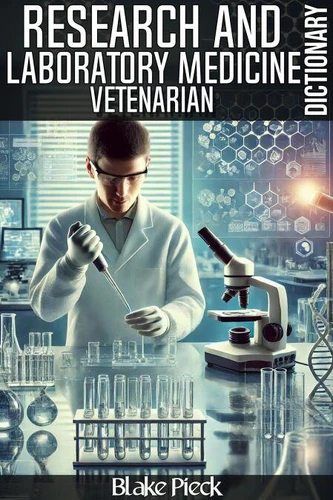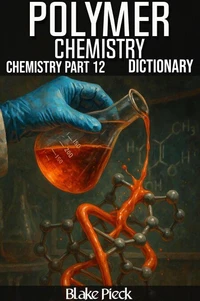Vetenarian – Research and Laboratory Medicine Dictionary. Grow Your Vocabulary
Par :Formats :
Disponible dans votre compte client Decitre ou Furet du Nord dès validation de votre commande. Le format ePub est :
- Compatible avec une lecture sur My Vivlio (smartphone, tablette, ordinateur)
- Compatible avec une lecture sur liseuses Vivlio
- Pour les liseuses autres que Vivlio, vous devez utiliser le logiciel Adobe Digital Edition. Non compatible avec la lecture sur les liseuses Kindle, Remarkable et Sony
 , qui est-ce ?
, qui est-ce ?Notre partenaire de plateforme de lecture numérique où vous retrouverez l'ensemble de vos ebooks gratuitement
Pour en savoir plus sur nos ebooks, consultez notre aide en ligne ici
- FormatePub
- ISBN8230455165
- EAN9798230455165
- Date de parution31/03/2025
- Protection num.pas de protection
- Infos supplémentairesepub
- ÉditeurIndependently Published
Résumé
Research and laboratory medicine in veterinary studies focus on the scientific investigation of animal diseases, treatments, and biological processes to improve both animal and human health. Veterinary researchers work in diagnostic laboratories, pharmaceutical companies, universities, and government agencies, studying everything from infectious diseases to genetic disorders and the development of new medical treatments.
This field plays a crucial role in advancing veterinary medicine, improving public health, and enhancing food safety. This dictionary provides in-depth knowledge of the various diagnostic techniques, laboratory tests, and pathological investigations used in veterinary medicine, helping professionals gain a comprehensive understanding of the scientific aspects of animal health care. Diagnostic Imaging - Diagnostic imaging in veterinary medicine involves the use of advanced technology to visualize the internal structures of animals, aiding in the diagnosis of a variety of conditions.
This includes X-rays, ultrasound, CT scans, and MRI, which help veterinarians detect fractures, tumors, infections, and other internal abnormalities. Diagnostic imaging is critical for non-invasive diagnosis, guiding treatment plans, and monitoring the progress of diseases. It plays a key role in enhancing veterinary care by providing clear and accurate images to support clinical decisions. Laboratory Testing - Laboratory testing in veterinary medicine is essential for diagnosing diseases, monitoring animal health, and supporting treatment plans.
This includes blood tests, urine analysis, tissue biopsies, and microbiological cultures, which help detect infections, metabolic disorders, and organ dysfunctions. Laboratory testing is a cornerstone of veterinary diagnostics, allowing for accurate identification of pathogens, toxins, or genetic issues. It also aids in the development of new treatments and preventive measures for various animal diseases, providing essential data for veterinary professionals.
Pathology - Pathology in veterinary medicine focuses on the study of disease processes and the identification of the underlying causes of illness in animals. Veterinary pathologists examine tissue samples, organs, and bodily fluids to diagnose diseases, assess the severity of conditions, and determine the cause of death in animals. This section covers the role of pathology in understanding diseases at the cellular and molecular levels, including cancer, infections, and genetic conditions.
Pathology is vital for informing treatment decisions, advancing scientific knowledge, and improving animal health outcomes.
This field plays a crucial role in advancing veterinary medicine, improving public health, and enhancing food safety. This dictionary provides in-depth knowledge of the various diagnostic techniques, laboratory tests, and pathological investigations used in veterinary medicine, helping professionals gain a comprehensive understanding of the scientific aspects of animal health care. Diagnostic Imaging - Diagnostic imaging in veterinary medicine involves the use of advanced technology to visualize the internal structures of animals, aiding in the diagnosis of a variety of conditions.
This includes X-rays, ultrasound, CT scans, and MRI, which help veterinarians detect fractures, tumors, infections, and other internal abnormalities. Diagnostic imaging is critical for non-invasive diagnosis, guiding treatment plans, and monitoring the progress of diseases. It plays a key role in enhancing veterinary care by providing clear and accurate images to support clinical decisions. Laboratory Testing - Laboratory testing in veterinary medicine is essential for diagnosing diseases, monitoring animal health, and supporting treatment plans.
This includes blood tests, urine analysis, tissue biopsies, and microbiological cultures, which help detect infections, metabolic disorders, and organ dysfunctions. Laboratory testing is a cornerstone of veterinary diagnostics, allowing for accurate identification of pathogens, toxins, or genetic issues. It also aids in the development of new treatments and preventive measures for various animal diseases, providing essential data for veterinary professionals.
Pathology - Pathology in veterinary medicine focuses on the study of disease processes and the identification of the underlying causes of illness in animals. Veterinary pathologists examine tissue samples, organs, and bodily fluids to diagnose diseases, assess the severity of conditions, and determine the cause of death in animals. This section covers the role of pathology in understanding diseases at the cellular and molecular levels, including cancer, infections, and genetic conditions.
Pathology is vital for informing treatment decisions, advancing scientific knowledge, and improving animal health outcomes.
Research and laboratory medicine in veterinary studies focus on the scientific investigation of animal diseases, treatments, and biological processes to improve both animal and human health. Veterinary researchers work in diagnostic laboratories, pharmaceutical companies, universities, and government agencies, studying everything from infectious diseases to genetic disorders and the development of new medical treatments.
This field plays a crucial role in advancing veterinary medicine, improving public health, and enhancing food safety. This dictionary provides in-depth knowledge of the various diagnostic techniques, laboratory tests, and pathological investigations used in veterinary medicine, helping professionals gain a comprehensive understanding of the scientific aspects of animal health care. Diagnostic Imaging - Diagnostic imaging in veterinary medicine involves the use of advanced technology to visualize the internal structures of animals, aiding in the diagnosis of a variety of conditions.
This includes X-rays, ultrasound, CT scans, and MRI, which help veterinarians detect fractures, tumors, infections, and other internal abnormalities. Diagnostic imaging is critical for non-invasive diagnosis, guiding treatment plans, and monitoring the progress of diseases. It plays a key role in enhancing veterinary care by providing clear and accurate images to support clinical decisions. Laboratory Testing - Laboratory testing in veterinary medicine is essential for diagnosing diseases, monitoring animal health, and supporting treatment plans.
This includes blood tests, urine analysis, tissue biopsies, and microbiological cultures, which help detect infections, metabolic disorders, and organ dysfunctions. Laboratory testing is a cornerstone of veterinary diagnostics, allowing for accurate identification of pathogens, toxins, or genetic issues. It also aids in the development of new treatments and preventive measures for various animal diseases, providing essential data for veterinary professionals.
Pathology - Pathology in veterinary medicine focuses on the study of disease processes and the identification of the underlying causes of illness in animals. Veterinary pathologists examine tissue samples, organs, and bodily fluids to diagnose diseases, assess the severity of conditions, and determine the cause of death in animals. This section covers the role of pathology in understanding diseases at the cellular and molecular levels, including cancer, infections, and genetic conditions.
Pathology is vital for informing treatment decisions, advancing scientific knowledge, and improving animal health outcomes.
This field plays a crucial role in advancing veterinary medicine, improving public health, and enhancing food safety. This dictionary provides in-depth knowledge of the various diagnostic techniques, laboratory tests, and pathological investigations used in veterinary medicine, helping professionals gain a comprehensive understanding of the scientific aspects of animal health care. Diagnostic Imaging - Diagnostic imaging in veterinary medicine involves the use of advanced technology to visualize the internal structures of animals, aiding in the diagnosis of a variety of conditions.
This includes X-rays, ultrasound, CT scans, and MRI, which help veterinarians detect fractures, tumors, infections, and other internal abnormalities. Diagnostic imaging is critical for non-invasive diagnosis, guiding treatment plans, and monitoring the progress of diseases. It plays a key role in enhancing veterinary care by providing clear and accurate images to support clinical decisions. Laboratory Testing - Laboratory testing in veterinary medicine is essential for diagnosing diseases, monitoring animal health, and supporting treatment plans.
This includes blood tests, urine analysis, tissue biopsies, and microbiological cultures, which help detect infections, metabolic disorders, and organ dysfunctions. Laboratory testing is a cornerstone of veterinary diagnostics, allowing for accurate identification of pathogens, toxins, or genetic issues. It also aids in the development of new treatments and preventive measures for various animal diseases, providing essential data for veterinary professionals.
Pathology - Pathology in veterinary medicine focuses on the study of disease processes and the identification of the underlying causes of illness in animals. Veterinary pathologists examine tissue samples, organs, and bodily fluids to diagnose diseases, assess the severity of conditions, and determine the cause of death in animals. This section covers the role of pathology in understanding diseases at the cellular and molecular levels, including cancer, infections, and genetic conditions.
Pathology is vital for informing treatment decisions, advancing scientific knowledge, and improving animal health outcomes.























